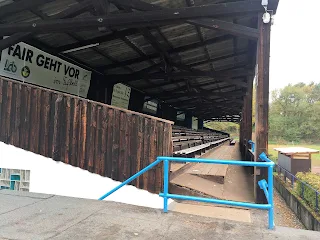Verein für Rasenspiele 1906 Kaiserslautern e.V. is a football club from the south western German city of Kaiserslautern that was formed through a complicated series of mergers of other local clubs.
Three other clubs, VfB 1906, FC Barbarossa 08 and FC Viktoria 05, merged to become Kaiserslauterer Fußball-Vereinigung 1910. The new club would rename itself SpVgg 1910, amalgamating with FC Bayern 1906 Kaiserslautern in March 1920 to form the club that became known as VfR Kaiserslautern.
In 1925, the clubs Waldstadion am Erbsenberg opened. During the Second World War, the club joined forces temporarily with 1. FC Kaiserlautern to compete in Gauliga Westmark, one of sixteen top-flight regional divisions, established by the ruling Third Reich. When peace was restored, the club wasn’t included in Oberliga Saarpfalz.
Instead, they competed in Amateurliga Westphalia. Under head coach and local hero Fritz Walter, the team reached Oberliga Südwest for the 1949-50 season. German international, Ernst Otto Willimowski, played for VfR from 1951 to 1955 as the club continued playing in one of the several top-level leagues.
VfR were relegated in both 1958-59 and 1960-61, but on both occasions the team regrouped and won promotion to the Oberliga at the first attempt. Following the advent of the Bundesliga from the 1963-64 season, VfR were given a place in Regionalliga Südwest, one of five second-tier divisions.
The club was relegated to Amateurliga Südwest, where the team won the league title in 1965-66 but failed to secure promotion through the play-off rounds. VfR finished as runners-up behind FC Phönix Bellheim in 1970-71.
The 1974-75 campaign saw the club descend to the Bezirksliga, where the team remained over the next few decades, with one or two ups and downs, including a spell in the Bezirksklasse Westpfalz Nord, one of 450 ninth-level divisions around Germany.
VfR finished as runners-up in 2011-12, 2012-13, 2013-14 and 2014-15 before the team won promotion back to the eighth-tier Bezirksliga Westpfalz, where the club finished in fourth position in the 2016-17 season.
The goals of
Timo Mangold helped VfR to runners-up in 2017-18 to win promotion to the seventh-tier Landesliga
West, where they averted relegation in 2018-19. The team found itself in a similar
position in 2019-20, under trainer Christopher Lamprecht, when the COVID-19 pandemic halted proceedings.
The side won Staffel Nord of the divisional level the season after finding itself in Landesliga West Südwest when things eventually got back to normal in 2022-23. VfR were relegated the following season back down to Bezirksliga Westpfalz with Babak Anisi at the helm. He was replaced as trainer by Moritz Nicolay for the 2024-25 campaign.
VfR Kaiserslautern will play in Bezirksliga Westpfalz in the 2025-26 season.
My visit
Sunday 22nd October 2017
I’d awoken in my Frankfurt hotel in not the best condition, which I put down to the local applewein. Nevertheless, I wasn’t going to let a bit of a hangover stop me from enjoying the third day of my latest German adventure.
I’d awoken in my Frankfurt hotel in not the best condition, which I put down to the local applewein. Nevertheless, I wasn’t going to let a bit of a hangover stop me from enjoying the third day of my latest German adventure.
A bit of bread and cheese, along with a coffee and water, began to bring me round as I boarded my train, before changing onto a more local service at Mannheim. The ride to Kaiserslautern took in some fine scenery as we went along through some steep-sided valleys.
There were over three hours before the kick-off of my match in the city; the second-tier Bundesliga clash between 1. FC Kaiserslautern and MSV Duisburg, so a walk up the hill to visit VfR Kaiserslautern fitted perfectly into my plans.
From the main station, I walked along Kohlenhofstraße and then the start of the hill of Kantstraße before taking the narrow lane of Erbsenberg, where a flight of steps took me straight to the entrance of Waldstadion am Erbsenberg.
The clubhouse was due to open twenty minutes later, and the gates to the ground were open, allowing me to have a good look inside and take some photos. I was glad I made the effort to see a historic old venue.
The centrepiece was an old wooden raised grandstand with the clubhouse behind it. Some overgrown open terracing stood on either side. Both ends had curves, but without a track. The Süd curve had more terracing and a scoreboard, with a red clay pitch behind.
The far touchline had further overgrown open steps; as I suspect did the Nord curve, albeit now masked by trees and greenery. I could hear youthful voices coming from the small pitch behind that end.
It wasn’t difficult to imagine the ground teaming with 15,000 fans cheering on their heroes in local derbies in years gone by. It still maintained a special aura and charm that modern-built grounds couldn't match.
Once done, I headed back down the hill and into town, before heading back uphill to the 1. FC Kaiserslautern game, which can be read about here.














No comments:
Post a Comment